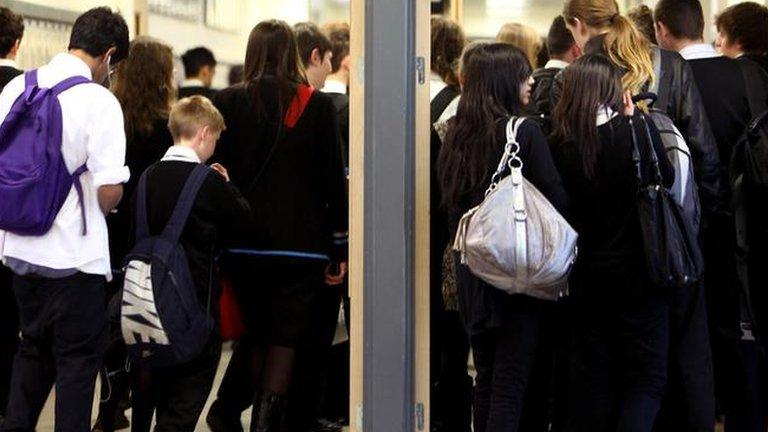Reality check: How easy are the annual Scottish schools stats to understand?
- Published

Smarter. Fitter. Healthier.
That's not the slogan for the latest instalment of the Jurassic Park franchise, but rather the key message behind the Scottish government's latest statistics on school leavers.
The 34-page report, external is a dizzying data dump of information from four separate sources, showing how a record percentage of young people are entering higher education or the work force on leaving school.
But the report is far more wide-ranging than that, covering the increase in free school meal distribution and how much more physical exercise little Sally or Johnny are getting.

Why would the government issue such a large and varied amount of data on a single day?
Well, that's a good, and obvious, question.
The cynical among you might argue it bogs down external analysts trying to dissect the data - others could argue it's an attempt to bury bad news in a discombobulating stat-heavy document.
And that's even assuming you know what the Scottish Credit and Qualifications Framework (SCQF) levels are, or what the difference is between a National, Standard and Intermediate qualification.
But in past the BBC has been told this avalanche of annual data is an attempt to eradicate the regular publication of "education statistics every second day" where "one was up, one was down" making it "impossible to get any real view of what was taking place".
Thankfully the kind folks at Holyrood provided the Study Guides version of the data, external.

What do you find if you look more closely at the leavers stats?
If you're a data-masochist like myself, I find it's always more "interesting" to delve into the full report.
The publication has joined two data sources from the Scottish Qualifications Authority (SQA) and Skills Development Scotland (SDS) in an attempt to map the journey of someone leaving school.
Basically, the data from the former tells us when youngsters left school and with what qualification; the latter tells us where they ended up a number of months later.
The full report re-iterates the fact that more than 91% of school leavers end up in higher education or finding a job, and that two-thirds of them now stay on until S6.
To reach such a conclusion, the report states the SDS data was matched to the national pupil census.
Makes sense so far, right?
The report continues: "This means some leavers are excluded from the analysis… Only leavers with a match to the pupil census are included in the analysis within this publication."
Now unsurprisingly this fine print doesn't appear in the press release. It's unclear what percentage of pupils weren't matched for the report, but it arguably could skew the overall conclusions.

What of the data on qualifications?
At the end of the document there's a note stating that the publication uses the "latest and best" approach for the qualification data.
So, if a pupil attains a D at say SQCF level 5, that level isn't counted. It would be counted as attaining "SCQF level 4 or better".
Now it could be argued that this doesn't matter - after all, the report maps the overall journey of students and whether they fail or not is unimportant so long as they reach a "positive destination".
But the "latest and best" approach not only seems to obscure the picture of academic success in Scottish schools, but also means the question of why pupils may be falling at certain hurdles or levels is never asked.

What was interesting about the PE stats?
Lastly, the press release lauds the fact that 98% of schools are meeting the government's physical education targets.
But a closer look at the data shows a considerably different outcome for children in secondary schools in Shetland Islands and Falkirk.
While schools in the majority of council areas are ensuring their pupils get at least 100 minutes of exercise a week, that rate has decreased to 57% in Shetland and 63% in Falkirk.
Obviously, I'm nit-picking here and, even though there are some minor concerns over the data, density and timing of the report, it is all there for parents, educationalist (and data junkies) to wade through.
- Published17 June 2015
